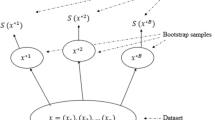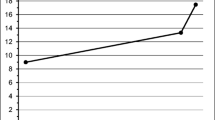Summary
This note gives some critical remarks on a study of Burns and Frech, concerning the explanation of income inequality levels in Dutch municipalities. It is stated that their conclusions are not correct, because of a wrong interpretation of the Gini-coefficient of income inequality. Results using the correctly defined Gini coefficient are presented, and also results using the coefficient of Theil, as a measure of income inequality.
Conclusions based on these results would differ significantly from those of Burns and Frech, and Tinbergen.
Furthermore, the sensitivity of the results for the observational units is taken into consideration. It is stated, however, that the obtained results are not yet usable to draw policy conclusions (as has been done by Tinbergen), as the estimated coefficients are too unreliable. This can be attributed to the severe multicollinearity in the data set.
Similar content being viewed by others
References
Al-Samarrie, A. andH. P. Miller, ‘State Differentials in Income Concentration,’American Economic Review, LVII (1967), pp. 57–72.
Bartels, C. P. A. andH. Van Metelen, ‘Een vergelijkende empirische analyse van inkomensongelijkheids maatstaven (1974),'Research-memorandum No. 13, Economic Faculty, Free University, Amsterdam.
Burns, L. S. andH. E. Frech III, ‘Human Capital and the Size Distribution of Incomes in Dutch Cities,’ De Economist, CXVIII (1970), pp. 598–618.
C.B.S.,Regional Pocket Yearbook, 1972, 's-Gravenhage, 1973.
C.B.S.,13th General Census of Population. 1960, Volume 8 B: Education received and overall level of education, Principal data for each municipality Zeist, 1964b. Volume 10 B: Economical active population: Principal data for each municipality, Zeist, 1964c. Volume 14: Principle keynumbers for each municipality, 's-Gravenhage, 1966.
C.B.S.,Income distribution, 1960. Regional data, Zeist, 1964a.
Desaeyere, W., K. Tavernier andE. Van Loon, ‘Meten en verklaren van de personele inkomensverdeling in België,’Bijdrage Elfde Vlaamse Wetenschappelijk Economisch Congres, Leuven, 1973.
Farrar, D. E. andR. R. Glauber, ‘Multicollinearity in Regression Analysis: The Problem Revisited,’Review of Economics and Statistics, IL (1967), pp. 92–107.
Klaassen, L. H.,De functie van Twente in de Nederlandse economie, Rotterdam, 1968.
Koutsoyiannis, A.,Theory of Econometrics, London, 1973.
Tinbergen, J.,Development Planning, London, 1967.
Tinbergen, J., ‘The Impact of Education on Income Distribution,’Review of Income and Wealth, 18 (1972), pp. 255–265.
Author information
Authors and Affiliations
Rights and permissions
About this article
Cite this article
Bartels, C.P.A., Bertens, A.M. The size distribution of income in Dutch municipalities and regions. Some critical remarks. De Economist 123, 134–146 (1975). https://doi.org/10.1007/BF02078434
Issue Date:
DOI: https://doi.org/10.1007/BF02078434




